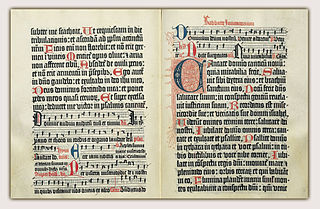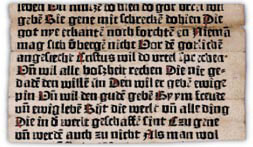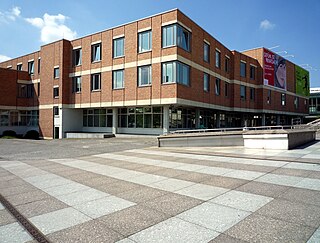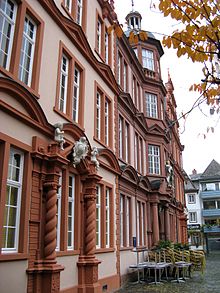
Johannes Gensfleisch zur Laden zum Gutenberg was a German inventor and craftsman who introduced letterpress printing to Europe with his movable-type printing press. Though not the first of its kind, earlier designs were restricted to East Asia, and Gutenberg's version was the first to spread across the world. His work led to an information revolution and the unprecedented mass-spread of literature throughout Europe. It also had a direct impact on the development of the Renaissance, Reformation and humanist movement.

The Gutenberg Bible was the earliest major book printed using mass-produced movable metal type in Europe. It marked the start of the "Gutenberg Revolution" and the age of printed books in the West. The book is valued and revered for its high aesthetic and artistic qualities as well as its historical significance. It is an edition of the Latin Vulgate printed in the 1450s by Johannes Gutenberg in Mainz, in present-day Germany. Forty-nine copies have survived. They are thought to be among the world's most valuable books, although no complete copy has been sold since 1978. In March 1455, the future Pope Pius II wrote that he had seen pages from the Gutenberg Bible displayed in Frankfurt to promote the edition, and that either 158 or 180 copies had been printed.
The Summa grammaticalis quae vocatur Catholicon, or Catholicon, is a 13th-century Latin dictionary which found wide use throughout Latin Christendom. Some of the entries contain encyclopedic information, and a Latin grammar is also included. The work was created by John Balbi, of Genoa, a Dominican, who finished it on March 7, 1286. The work served in the late Middle Ages to interpret the Bible. The Catholicon was one of the first books to be printed, using the new printing technology of Johannes Gutenberg in 1460.

Peter Schöffer or Petrus Schoeffer was an early German printer, who studied in Paris and worked as a manuscript copyist in 1451 before apprenticing with Johannes Gutenberg and joining Johann Fust, a goldsmith, lawyer, and money lender.

An Ex Libris, also known as a bookplate, is a printed or decorative label pasted into a book, often on the front endpaper, to indicate ownership. Simple typographical bookplates are termed "book labels".

The Museum of Design, Zürich is a museum for industrial design, visual communication, architecture, and craft in Zurich, Switzerland.

The Mainz Psalter was the second major book printed with movable type in the West; the first was the Gutenberg Bible. It is a psalter commissioned by the Mainz archbishop in 1457. The Psalter introduced several innovations: it was the first book to feature a printed date of publication, a printed colophon, two sizes of type, printed decorative initials, and the first to be printed in three colours. The colophon also contains the first example of a printer's mark. It was the first important publication issued by Johann Fust and Peter Schoeffer following their split from Johannes Gutenberg.
The Officina Bodoni was a private press operated by Giovanni Mardersteig from 1922. It was named after the great eighteenth-century Italian typographer Giambattista Bodoni. The Officina Bodoni is known for printing books of the very highest quality and the finest craftsmanship.

The Sibyllenbuchfragment is a partial book leaf which may be the earliest surviving remnant of any European book that was printed using movable type. The Sibyllenbuch, or Book of the Sibyls, was a medieval poem which held prophecies concerning the fate of the Holy Roman Empire.

The Gutenberg-Jahrbuch is an annual periodical publication covering the history of printing and the book. Its focus is on incunables, early printing, and the life and work of Johannes Gutenberg, inventor of the modern printed book. It has been published since 1926 by the Internationale Gutenberg-Gesellschaft, the international association for the study of the history and development of printing technology and written media. Dr Stephan Füssel was editor from 1994-2022.

Gero Trauth is a German painter, graphic artist, porcelain illustrator and designer.

The Kupferstichkabinett, or Museum of Prints and Drawings, is a prints museum in Berlin, Germany. It is part of the Berlin State Museums, and is located in the Kulturforum on Potsdamer Platz. It is the largest museum of graphic art in Germany, with more than 500,000 prints and around 110,000 individual works on paper.

Michael Ebling is a German politician of the Social Democratic Party (SPD) who served as State Minister of the Interior in the government of Minister-President Malu Dreyer of Rhineland-Palatinate since 2022. From 2012 to 2022, he was the mayor of Mainz.

Henri Friedlaender (1904–1996) was an Israeli typographer and book designer. He co-founded the Hadassah Printing School and served as the first director of the school.

Ricardo J. Vicent Museros was a Spanish printer and publisher. After studying in Germany he returned to Valencia with new methods of work, advertising and graphic marketing. He founded the "Museo Nacional de la Imprenta y la Obra Gráfica" in El Puig de Santa María. He promoted the twinning of the cities of Valencia and Mainz (Germany). In 1992, the International Gutenberg Society granted him the "Gutenberg Prize" and in 2003 he received the "Cross of Civil Merit" from the German government for his work in favour of cultural relations between Spain and Germany.
Monika Kropshofer is a German painter and photographer. Since the middle of the year 2000 Kropshofer has gained renown through her large-format painted landscape and architecture photographs which were created as a result of her many work journeys and stays in Europe, Africa und Asia.
The following is a timeline of the history of the city of Mainz, Germany.
As of 2018, ten firms in Germany rank among the world's biggest publishers of books in terms of revenue: C.H. Beck, Bertelsmann, Cornelsen Verlag, Haufe-Gruppe, Holtzbrinck Publishing Group, Ernst Klett Verlag, Springer Nature, Thieme, WEKA Holding, and Westermann Druck- und Verlagsgruppe. Overall, "Germany has some 2,000 publishing houses, and more than 90,000 titles reach the public each year, a production surpassed only by the United States." Unlike many other countries, "book publishing is not centered in a single city but is concentrated fairly evenly in Berlin, Hamburg, and the regional metropolises of Cologne, Frankfurt, Stuttgart, and Munich."
Leopold Fischer (1902-1978) was an Austrian police officer and much-awarded Pictorialist, and later, Modernist, photographer.

The Mainzer Stadtschreiber is an annual German literature award. It is awarded by ZDF, 3sat and the city of Mainz and was founded in 1984. The award is endowed with €12,500. Additionally the laureate receives the right to live in the town clerk's domicile in the Gutenberg Museum in Mainz for one year. Together with ZDF, the recipient is able to produce a documentary based on a free choice of topic.















